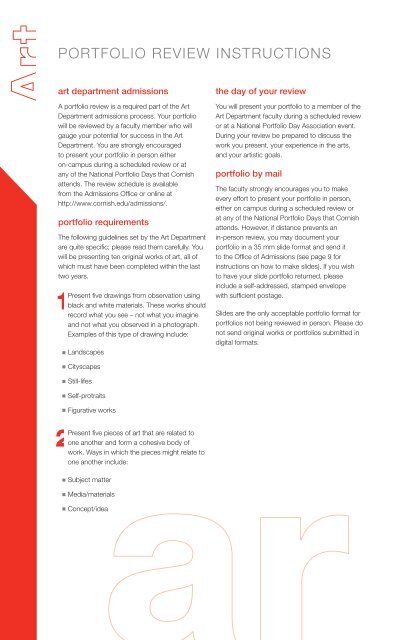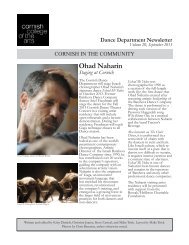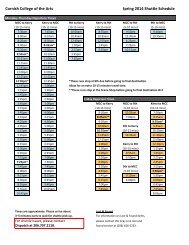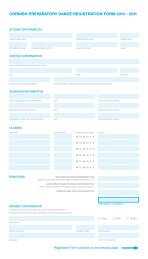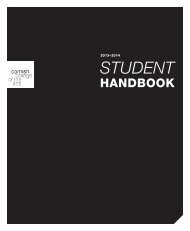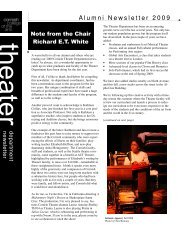PORTFOLIO REVIEW INSTRUCTIONS - Cornish College of the Arts
PORTFOLIO REVIEW INSTRUCTIONS - Cornish College of the Arts
PORTFOLIO REVIEW INSTRUCTIONS - Cornish College of the Arts
You also want an ePaper? Increase the reach of your titles
YUMPU automatically turns print PDFs into web optimized ePapers that Google loves.
<strong>PORTFOLIO</strong> <strong>REVIEW</strong> <strong>INSTRUCTIONS</strong><br />
art department admissions<br />
A portfolio review is a required part <strong>of</strong> <strong>the</strong> Art<br />
Department admissions process. Your portfolio<br />
will be reviewed by a faculty member who will<br />
gauge your potential for success in <strong>the</strong> Art<br />
Department. You are strongly encouraged<br />
to present your portfolio in person ei<strong>the</strong>r<br />
on-campus during a scheduled review or at<br />
any <strong>of</strong> <strong>the</strong> National Portfolio Days that <strong>Cornish</strong><br />
attends. The review schedule is available<br />
from <strong>the</strong> Admissions Office or online at<br />
http://www.cornish.edu/admissions/.<br />
portfolio requirements<br />
The following guidelines set by <strong>the</strong> Art Department<br />
are quite specific; please read <strong>the</strong>m carefully. You<br />
will be presenting ten original works <strong>of</strong> art, all <strong>of</strong><br />
which must have been completed within <strong>the</strong> last<br />
two years.<br />
1<br />
Present five drawings from observation using<br />
black and white materials. These works should<br />
record what you see – not what you imagine<br />
and not what you observed in a photograph.<br />
Examples <strong>of</strong> this type <strong>of</strong> drawing include:<br />
Landscapes<br />
<strong>the</strong> day <strong>of</strong> your review<br />
You will present your portfolio to a member <strong>of</strong> <strong>the</strong><br />
Art Department faculty during a scheduled review<br />
or at a National Portfolio Day Association event.<br />
During your review be prepared to discuss <strong>the</strong><br />
work you present, your experience in <strong>the</strong> arts,<br />
and your artistic goals.<br />
portfolio by mail<br />
The faculty strongly encourages you to make<br />
every effort to present your portfolio in person,<br />
ei<strong>the</strong>r on campus during a scheduled review or<br />
at any <strong>of</strong> <strong>the</strong> National Portfolio Days that <strong>Cornish</strong><br />
attends. However, if distance prevents an<br />
in-person review, you may document your<br />
portfolio in a 35 mm slide format and send it<br />
to <strong>the</strong> Office <strong>of</strong> Admissions (see page 9 for<br />
instructions on how to make slides). If you wish<br />
to have your slide portfolio returned, please<br />
include a self-addressed, stamped envelope<br />
with sufficient postage.<br />
Slides are <strong>the</strong> only acceptable portfolio format for<br />
portfolios not being reviewed in person. Please do<br />
not send original works or portfolios submitted in<br />
digital formats.<br />
2<br />
Cityscapes<br />
Still-lifes<br />
Self-protraits<br />
Figurative works<br />
Present five pieces <strong>of</strong> art that are related to<br />
one ano<strong>the</strong>r and form a cohesive body <strong>of</strong><br />
work. Ways in which <strong>the</strong> pieces might relate to<br />
one ano<strong>the</strong>r include:<br />
Subject matter<br />
Media/materials<br />
Concept/idea
how to make slides<br />
For Art, Design and Performance Production<br />
Care should be taken when photographing<br />
your work to make certain <strong>the</strong> quality and<br />
detail show in <strong>the</strong> slides. If possible, consult<br />
a pr<strong>of</strong>essional for photographing your artwork.<br />
Your high school or college instructors might also<br />
be able to assist you. If your work is small-scale<br />
and you have access to a copy stand, we recommend<br />
its use; it will provide better conditions<br />
for consistent and even lighting <strong>of</strong> your work.<br />
If photographing your work on your own, follow<br />
<strong>the</strong>se general instructions:<br />
We recommend Kodak E-6 35 mm outdoor slide<br />
film. Best results will come by photographing your<br />
work outdoors on an overcast day; you will be<br />
using <strong>the</strong> diffuse daylight as your light source.<br />
Find an exterior wall that is facing <strong>the</strong> sun. Use<br />
a black surface as your background such as a<br />
black cloth drape or board.<br />
Shoot one work at a time; do not combine<br />
pieces into one slide. Focus <strong>the</strong> camera on<br />
<strong>the</strong> artwork and set <strong>the</strong> f-stop (aperture setting)<br />
at 11 or smaller.<br />
Take at least 3 exposures <strong>of</strong> each piece,<br />
setting <strong>the</strong> camera to a different shutter speed<br />
each time and leaving <strong>the</strong> f-stop <strong>the</strong> same<br />
(a.k.a. bracketing).<br />
Have your film developed at a quality photo lab.<br />
presentation <strong>of</strong> your slide portfolio<br />
Slides should be placed in a single 11” x 8” threehole<br />
punched, clear transparent slide sleeve. For<br />
<strong>the</strong> best results please make computer printed<br />
labels or print clearly using a fine tip permanent<br />
black marker. Each slide should be labeled as<br />
follows:<br />
Your name<br />
Title <strong>of</strong> <strong>the</strong> work<br />
Size (height x width)<br />
Media/Materials<br />
Place a red dot in <strong>the</strong> upper right hand<br />
corner, when viewing <strong>the</strong> slide.<br />
Slides should be numbered in viewing order.


